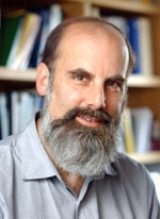
Matthew P. Scott
Encyclopedia
Matthew P. Scott is a developmental biologist
and HHMI investigator at Stanford University
studying how embryonic and later development is governed by proteins that control gene
activity and cell signaling
processes.
He independently discovered homeobox
genes in Drosophila melanogaster
working with Amy J. Weiner at the University of Indiana.
Among his laboratory's many subsequent discoveries, he is recognized for the cloning of the patched
gene family and demonstration that a human homolog PTCH1
is a key tumor suppressor gene for the Hedgehog signaling pathway
as well as the causative gene for the nevoid basal cell carcinoma syndrome
, or Gorlin syndrome.
starting in 1983. He moved to Stanford University
in 1990 to join the faculty of the Department of Developmental Biology and the Department of Genetics. From 2002-2007 he was Chair of Bio-X, Stanford's interdisciplinary biosciences program.
He is married to Stanford developmental geneticist Margaret T. Fuller
.
Developmental biology
Developmental biology is the study of the process by which organisms grow and develop. Modern developmental biology studies the genetic control of cell growth, differentiation and "morphogenesis", which is the process that gives rise to tissues, organs and anatomy.- Related fields of study...
and HHMI investigator at Stanford University
Stanford University
The Leland Stanford Junior University, commonly referred to as Stanford University or Stanford, is a private research university on an campus located near Palo Alto, California. It is situated in the northwestern Santa Clara Valley on the San Francisco Peninsula, approximately northwest of San...
studying how embryonic and later development is governed by proteins that control gene
Gene
A gene is a molecular unit of heredity of a living organism. It is a name given to some stretches of DNA and RNA that code for a type of protein or for an RNA chain that has a function in the organism. Living beings depend on genes, as they specify all proteins and functional RNA chains...
activity and cell signaling
Cell signaling
Cell signaling is part of a complex system of communication that governs basic cellular activities and coordinates cell actions. The ability of cells to perceive and correctly respond to their microenvironment is the basis of development, tissue repair, and immunity as well as normal tissue...
processes.
He independently discovered homeobox
Homeobox
A homeobox is a DNA sequence found within genes that are involved in the regulation of patterns of anatomical development in animals, fungi and plants.- Discovery :...
genes in Drosophila melanogaster
Drosophila melanogaster
Drosophila melanogaster is a species of Diptera, or the order of flies, in the family Drosophilidae. The species is known generally as the common fruit fly or vinegar fly. Starting from Charles W...
working with Amy J. Weiner at the University of Indiana.
Among his laboratory's many subsequent discoveries, he is recognized for the cloning of the patched
Patched
Patched is a conserved 12-pass transmembrane protein receptor that plays an obligate negative regulatory role in the Hedgehog signaling pathway in insects and vertebrates. The original mutations in the ptc gene were discovered in the fruit fly Drosophila melanogaster by 1995 Nobel Laureates Eric F...
gene family and demonstration that a human homolog PTCH1
PTCH1
Protein patched homolog 1 is a protein that is the member of the Patched family and in humans is encoded by the PTCH1 gene.- Function :PTCH1 is a member of the patched gene family and is the receptor for sonic hedgehog, a secreted molecule implicated in the formation of embryonic structures and in...
is a key tumor suppressor gene for the Hedgehog signaling pathway
Hedgehog signaling pathway
In a growing embryo, cells develop differently in the head or tail end of the embryo, the left or right, and other positions. They also form segments which develop into different body parts. The hedgehog signaling pathway gives cells information that they need to make the embryo develop properly....
as well as the causative gene for the nevoid basal cell carcinoma syndrome
Nevoid basal cell carcinoma syndrome
Nevoid basal cell carcinoma syndrome , also known as basal cell nevus syndrome, multiple basal cell carcinoma syndrome, Gorlin syndrome, and Gorlin–Goltz syndrome, is an inherited medical condition involving defects within multiple body systems such as the skin, nervous system, eyes, endocrine...
, or Gorlin syndrome.
Biography
Scott served on the faculty of the Department of Molecular, Cellular, and Developmental Biology at the University of ColoradoUniversity of Colorado at Boulder
The University of Colorado Boulder is a public research university located in Boulder, Colorado...
starting in 1983. He moved to Stanford University
Stanford University
The Leland Stanford Junior University, commonly referred to as Stanford University or Stanford, is a private research university on an campus located near Palo Alto, California. It is situated in the northwestern Santa Clara Valley on the San Francisco Peninsula, approximately northwest of San...
in 1990 to join the faculty of the Department of Developmental Biology and the Department of Genetics. From 2002-2007 he was Chair of Bio-X, Stanford's interdisciplinary biosciences program.
He is married to Stanford developmental geneticist Margaret T. Fuller
Margaret T. Fuller
Margaret "Minx" T. Fuller is a developmental biologist known for her research on the male germ line and defining the role of the stem cell environment in specifying cell fate and differentiation., CDB Symposium 2007.Fuller is the Reed-Hodgson Professor of Human Biology at Stanford University, and...
.
Awards
- 1983 - Helen Hay Whitney postdoctoral fellowship
- 1985 - Searle Scholar
- Conklin Medal, Society for Developmental Biology
- 1999 - Member, National Academy of SciencesUnited States National Academy of SciencesThe National Academy of Sciences is a corporation in the United States whose members serve pro bono as "advisers to the nation on science, engineering, and medicine." As a national academy, new members of the organization are elected annually by current members, based on their distinguished and...
- 2007 - Member, National Institute of Medicine

